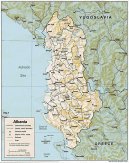| Introduction - Albania: |
| Location - Albania: |
| People - Albania: |
| Government - Albania: |
| Economy - Albania: |
Economy overview | Lagging behind its Balkan neighbors, Albania is making the difficult transition to a more modern open-market economy. The government has taken measures to curb violent crime and reduce the large gray economy. The economy is bolstered by annual remittances from abroad of $600-$800 million, mostly from Albanians residing in Greece and Italy; this helps offset the towering trade deficit. Agriculture, which accounts for about one-quarter of GDP, is held back because of lack of modern equipment, unclear property rights, and the prevalence of small, inefficient plots of land. Energy shortages and antiquated and inadequate infrastructure contribute to Albanias poor business environment, which make it difficult to attract and sustain foreign investment. The planned construction of a new thermal power plant near Vlore and improved transmission and distribution facilities eventually will help relieve the energy shortages. Also, the government is moving slowly to improve the poor national road and rail network, a long-standing barrier to sustained economic growth. On the positive side, growth was strong in 2003-06 and inflation is low and stable. |
|
Gdp purchasing power parity | $20.46 billion
note: Albania has a large gray economy that may be as large as 50% of official GDP (2006 est.) |
|
Gdp official exchange rate | $9.306 billion (2006 est.) |
|
Gdp real growth rate | 5% (2006 est.) |
|
Gdp per capita ppp | $5,700 (2006 est.) |
|
Gdp composition by sector | agriculture: 23.3%
industry: 18.8%
services: 57.9% (2006 est.) |
|
Labor force | 1.09 million (not including 352,000 emigrant workers) (September 2006 est.) |
|
Labor force by occupation | agriculture: 58%
industry: 15%
services: 27% (September 2006 est.) |
|
Unemployment rate | 13.8% official rate, but may exceed 30% due to preponderance of near-subsistence farming (September 2006 est.) |
|
Population below poverty line | 25% (2004 est.) |
|
Household income or consumption by percentage share | lowest 10%: NA%
highest 10%: NA% |
|
Distribution of family income gini index | 26.7 (2005) |
|
Inflation rate consumer prices | 2.5% (2006) |
|
Investment gross fixed | 24.5% of GDP (2006 est.) |
|
Budget | revenues: $2.608 billion
expenditures: $3.1 billion; including capital expenditures of $710 million (2007 est.) |
|
Agriculture products | wheat, corn, potatoes, vegetables, fruits, sugar beets, grapes; meat, dairy products |
|
Industries | food processing, textiles and clothing; lumber, oil, cement, chemicals, mining, basic metals, hydropower |
|
Industrial production growth rate | 3.4% (2005 est.) |
|
Electricity production | 5.451 billion kWh (2005) |
|
Electricity consumption | 3.53 billion kWh (2005) |
|
Electricity exports | 729 million kWh (2005) |
|
Electricity imports | 385 million kWh (2005) |
|
Oil production | 3,600 bbl/day (2005 est.) |
|
Oil consumption | 25,200 bbl/day (2005 est.) |
|
Oil exports | 1,240 bbl/day (2004 est.) |
|
Oil imports | 21,600 bbl/day (2005 est.) |
|
Oil proved reserves | 165 million bbl (1 January 2005) |
|
Natural gas production | 30 million cu m (2004 est.) |
|
Natural gas consumption | 30 million cu m (2004 est.) |
|
Natural gas exports | 0 cu m (2004 est.) |
|
Natural gas imports | 0 cu m (2004 est.) |
|
Natural gas proved reserves | 2.832 billion cu m (1 January 2005 est.) |
|
Current account balance | -$679.9 million (2006 est.) |
|
Exports | $763.2 million f.o.b. (2006 est.) |
|
Exports commodities | textiles and footwear; asphalt, metals and metallic ores, crude oil; vegetables, fruits, tobacco |
|
Exports partners | Italy 67.8%, Serbia and Montenegro 5.8%, Greece 5.4% (2006) |
|
Imports | $2.901 billion f.o.b. (2006 est.) |
|
Imports commodities | machinery and equipment, foodstuffs, textiles, chemicals |
|
Imports partners | Italy 32%, Greece 17.7%, Turkey 8%, Germany 5.6% (2006) |
|
Reserves of foreign exchange and gold | $1.621 billion (2006 est.) |
|
Debt external | $1.55 billion (2004) |
|
Economic aid recipient | ODA: $366 million
note: top donors were Italy, EU, Germany (2003 est.) |
|
Currency code | lek (ALL)
note: the plural of lek is leke |
|
Exchange rates | leke per US dollar - 98.384 (2006), 102.649 (2005), 102.78 (2004), 121.863 (2003), 140.155 (2002) |
|
| Communications - Albania: |
| Transportation - Albania: |
| Military - Albania: |
This page was last updated on 16 September, 2007



